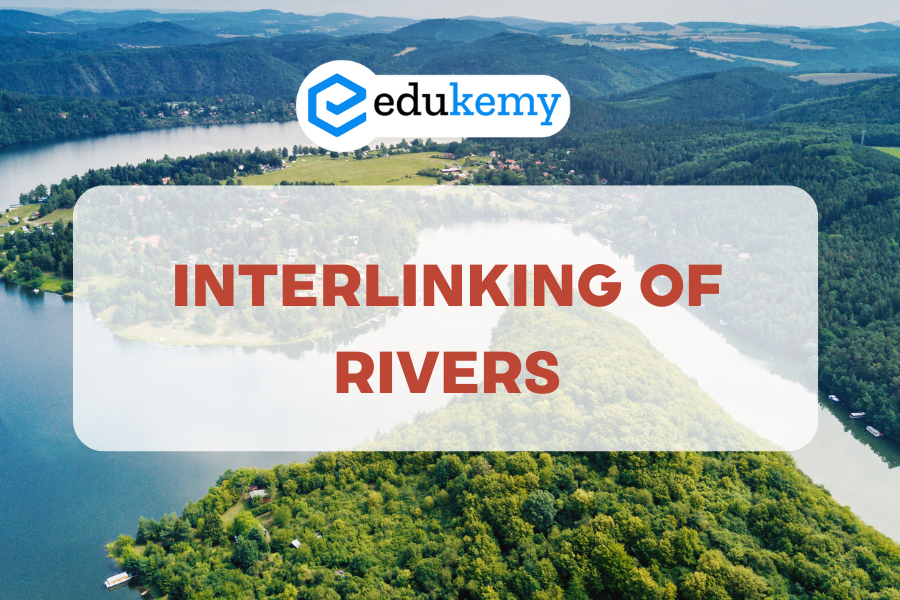Explore the interlinking of rivers in India, its impact on water management, agriculture, environment, & socio-economic growth. A key topic for UPSC aspirants.

Contents
- 1 Introduction
- 2 Check Shabbir Sir’s Class Notes
- 3 What is River Interlinking?
- 4 Historical Background
- 5 Key Objectives of River Interlinking
- 6 Key River Interlinking Projects
- 7 Advantages of River Interlinking
- 8 Challenges and Concerns
- 9 Environmental Perspectives
- 10 Way Forward
- 11 Conclusion
- 12 To get free counseling/support on UPSC preparation from expert mentors please call 9773890604
Introduction
The interlinking of rivers is one of the most ambitious projects in India, aimed at addressing the country’s uneven water distribution. For UPSC aspirants, especially those with Geography as an optional subject, this topic holds significant importance due to its multi-dimensional implications on water management, agriculture, environment, and socio-economic development.
Check Shabbir Sir’s Class Notes
Click Here to download
What is River Interlinking?
River interlinking involves transferring water from surplus river basins to deficit ones through a network of canals, dams, and reservoirs. This concept seeks to mitigate the challenges of water scarcity, floods, and droughts by balancing water distribution across regions.
Historical Background
- British Era: The idea of interlinking rivers was first proposed during the British period by Sir Arthur Cotton to address irrigation and navigation needs.
- Post-Independence: The concept gained momentum in the 1970s when Dr. K.L. Rao, a noted engineer, suggested the Ganga-Cauvery Link project. Later, Captain Dastur proposed the “Garland Canal” plan.
- National Perspective Plan (1980): The Ministry of Water Resources, in collaboration with the Central Water Commission, formulated this plan, which divides river interlinking projects into two components:
- Himalayan Component: Linking Himalayan rivers like the Ganga, Brahmaputra, and their tributaries.
- Peninsular Component: Linking rivers in southern India, such as the Krishna, Godavari, and Mahanadi.
Key Objectives of River Interlinking
- Water Scarcity Mitigation: To transfer water from surplus regions to drought-prone areas.
- Flood Management: To control floodwaters by diverting excess water to deficit areas.
- Agricultural Development: To expand irrigation potential and ensure year-round farming.
- Hydropower Generation: To harness untapped water resources for renewable energy production.
- Navigation and Connectivity: To promote inland water transport.
- Drinking Water Supply: To improve access to potable water in water-stressed regions.
Key River Interlinking Projects
- Ken-Betwa Link Project:
- States Involved: Madhya Pradesh and Uttar Pradesh
- Benefits: Irrigation, drinking water supply, and hydropower.
- Concerns: Environmental impact due to submergence of Panna Tiger Reserve.
- Godavari-Krishna Link:
- States Involved: Andhra Pradesh and Telangana
- Benefits: Reducing water shortages in Krishna Basin.
- Mahanadi-Godavari Link:
- Aimed at transferring surplus water from the Mahanadi basin to the Godavari basin to mitigate drought conditions in Andhra Pradesh.
- Ganga-Cauvery Link:
- Proposed to connect the Himalayan rivers with peninsular rivers to address regional imbalances in water availability.
Advantages of River Interlinking
- Agricultural Growth: Boosts food security by ensuring water availability for irrigation.
- Flood and Drought Mitigation: Balances regional water availability, reducing the impact of extreme weather events.
- Economic Benefits: Enhances rural livelihoods, generates employment, and boosts GDP.
- Energy Production: Promotes renewable hydropower generation.
- Water Navigation: Facilitates inland waterways, reducing transportation costs.
Challenges and Concerns
- Environmental Impact:
- Deforestation, habitat destruction, and loss of biodiversity.
- Submergence of protected areas and displacement of wildlife.
- Social Issues:
- Displacement of people due to construction of reservoirs and canals.
- Loss of livelihoods in affected areas.
- Economic Feasibility:
- High project costs and long gestation periods.
- Maintenance and operational challenges.
- Inter-State Disputes:
- Conflicts over water sharing and allocation.
- Lack of consensus among states.
- Hydrological and Geological Concerns:
- Changes in river flow patterns may impact sediment transport and groundwater recharge.
- Risk of geological instability in certain regions.
Environmental Perspectives
- Ecological Balance: Alteration in natural river flows can affect aquatic ecosystems.
- Climate Change: Changing precipitation patterns may affect water availability in donor basins.
- Sustainable Alternatives:
- Watershed management.
- Rainwater harvesting.
- Localized water storage solutions.
Way Forward
- Comprehensive Impact Assessment:
- Conduct thorough environmental and social impact assessments before implementation.
- Stakeholder Participation:
- Engage local communities, environmentalists, and policymakers in decision-making.
- Inter-State Cooperation:
- Foster consensus among states through dialogue and mutual agreements.
- Integrated Water Resource Management (IWRM):
- Promote sustainable and equitable water resource management practices.
- Phased Implementation:
- Prioritize smaller, feasible projects over large-scale interlinking schemes.
Conclusion
The interlinking of rivers offers immense potential to address India’s water-related challenges. However, it is not without significant environmental, social, and economic concerns. As future policymakers and administrators, UPSC aspirants must critically analyze this topic, balancing development goals with sustainability. Understanding the geographical, ecological, and socio-political dimensions of river interlinking will enable aspirants to formulate balanced perspectives for mains answers and essays.
To get free counseling/support on UPSC preparation from expert mentors please call 9773890604
- Join Geography Optional Course – Click Here
- Get Geography Hard Copy notes – Click Here

